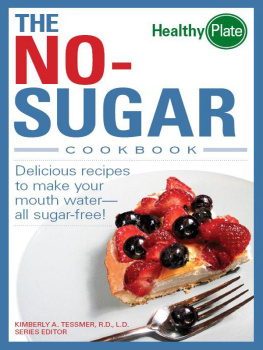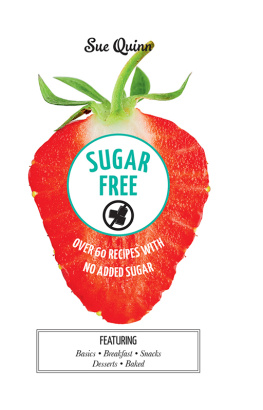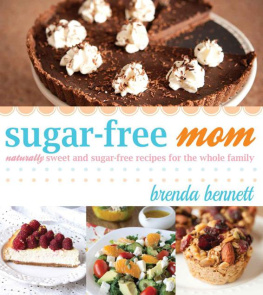Sue Simkins works as a recipe developer and writes recipe columns for several monthly magazines including Best of British, Country Smallholding and the Countryman. Her recipes cover the whole range of wholesome home cooking with plenty of baking. They are the kind of recipes that novice and experienced cooks will all enjoy: simple and delicious with helpful tips and explanations. Sue lives in Dorset with her family.
Also by Sue Simkins
Cooking with Mrs Simkins
Afternoon Tea
Fresh Bread and Bakes from Your Bread Machine
How to Make the Most of Your Food Processor
SUGAR FREE
BAKING
Sue Simkins

For David, David and Edie
ROBINSON
First published in Great Britain in 2011 by How To Books
This paperback edition published in Great Britain in 2015 by Robinson
Copyright Sue Simkins, 2011, 2015
The moral right of the author has been asserted.
All rights reserved.
No part of this publication may be reproduced, stored in a retrieval system, or transmitted, in any form, or by any means, without the prior permission in
writing of the publisher, nor be otherwise circulated in any form of binding or cover other than that in which it is published and without a similar condition
including this condition being imposed on the subsequent purchaser.
A CIP catalogue record for this book is available from the British Library.
ISBN 978-1-47211-988-0 (paperback)
ISBN: 978-1-47211-989-6 (ebook)
Robinson
is an imprint of
Constable & Robinson Ltd
100 Victoria Embankment
London EC4Y 0DY
An Hachette UK Company
www.hachette.co.uk
www.constablerobinson.com
Contents
Acknowledgements
I would like to thank my family and friends and everyone who has helped with the making of this book.
Special thanks to Gary Rhodes, Melissa Syers and Murray Hawkins.
Foreword
Reading this book inspired in me a hunger to cook and nibble amongst the many sweet fancies presented. It is even more of a pleasure to read how xylitol creates a sweet bite we can all enjoy.
I love the mix of fruity flavours, not forgetting the many British classics, which all help to inspire the mixing, whisking, baking, and of course, the best bit the eating.
Gary Rhodes
Introduction
This book contains delicious recipes that contain xylitol rather than sucrose or standard table sugar. Xylitol is a naturally occurring sweetener derived from wood or maize. It has been shown to confer significant oral health benefits. Whereas sucrose consumption leads to tooth decay, xylitol actively inhibits it. It encourages the remineralisation of teeth and inhibits streptococcus mutans, the acid-producing bacteria chiefly responsible for dental caries.
Xylitol contains about 40% less energy than sucrose and is absorbed from the gut more slowly. It is therefore of benefit to both dieters and sufferers of diabetes. There is also encouraging research to suggest that it may increase the activity of neutrophils the white blood cells which fight bacterial infections and may also be helpful in the control of oral thrush and osteoporosis.
Murray Hawkins BDS, DGPRCS (UK)
Using Xylitol as a Sugar Substitute
There are a number of healthy and low calorie natural sugar substitutes on the market. All have their advantages but xylitol is the best choice for the recipes in this book for three main reasons.
1 Baking is Easy
Xylitol is the all-round winner when it comes to baking. Because xylitol is as sweet, weight for weight, as regular sugar, you can use exactly the same amount of xylitol as you would sugar in your baking recipes. With other natural sugar substitutes, you need less of them if they are not to be overpowering and unbearably sweet, which means you need to add additional bulk to recipes for them to work.
2 Beneficial to Teeth
And, of course, the added advantage is, xylitol has also been shown to confer significant oral health benefits and actually inhibits dental caries, which means cakes made with xylitol not only dont harm your teeth but they are actually beneficial! How good is that!
3 Suitable for Diabetics
And finally, as the body does not require insulin to metabolise xylitol, it has become widely used as a sweetener for diabetics, in fact it was originally developed for this very purpose. If you are planning to include xylitol in a diabetic diet, always consult a medical professional beforehand for expert advice to suit individual requirements.
Incidentally, it was discovered during the 1950s that children who included xylitol in their diet developed fewer ear infections. Xylitol is a naturally occurring form of sugar (strictly speaking, it is a sugar alcohol), sometimes called birch sugar. Its found in certain fruits and plants such as oats, berries, maize and birch bark. It can be extracted from some of them: usually from maize husks or birch bark. Xylitol contains the same level of sweetness as regular sugar or sucrose but with approximately 40% fewer calories and 75% fewer available carbohydrates.
Xylitol has a low impact on blood sugar and very low glycaemic index (7 or 8, compared with sucrose, which is around 65, although studies vary). Xylitol is cariostatic, which means it doesnt cause tooth decay (dental caries) and can actually help guard against it. Xylitol encourages the growth of good bacteria in the gut and discourages the growth of yeast.
Xylitol was first discovered in the 1890s and was developed further several decades later in Europe as a safer sweetener than sugar for people with diabetes. Scientists in Finland found it was a useful alternative to beet sugar during the sugar shortages of the Second World War.
It became popular in Finland and by the 1970s Finnish scientists had discovered xylitols dental benefits.
The many health benefits of xylitol are widely documented. However, it can cause mild diarrhoea in some people if taken to excess, particularly if your body isnt used to it. Stick to a normal serving of cake a modest slice or two, or one or two individual cakes at a sitting and you should be fine. Possibly, if you were to eat an entire large cake all at once, you would experience some discomfort, but then again, it wouldnt be wise to eat that amount of cake made with regular sugar either! Just be sensible and take it steadily, particularly while your digestive system adapts to it.
Warning for Pets
Although beneficial for humans, xylitol much like chocolate and grapes is not suitable for dogs. In fact, it is not advisable to give it to any animal, so please keep anything made with xylitol, and xylitol itself, for human consumption only. If you suspect your dog has taken xylitol, please consult your vet immediately.
Oven Temperature Conversions
Mark 1 | 275F | 140C |
Mark 2 | 300F | 150C |
Mark 3 | 325F | 170C |
Mark 4 | 350F | 180C |
Mark 5 | 375F | 190C |
Mark 6 | 400F | 200C |
Mark 7 | 425F | 220C |
Mark 8 | 450F | 230C |
Next page











